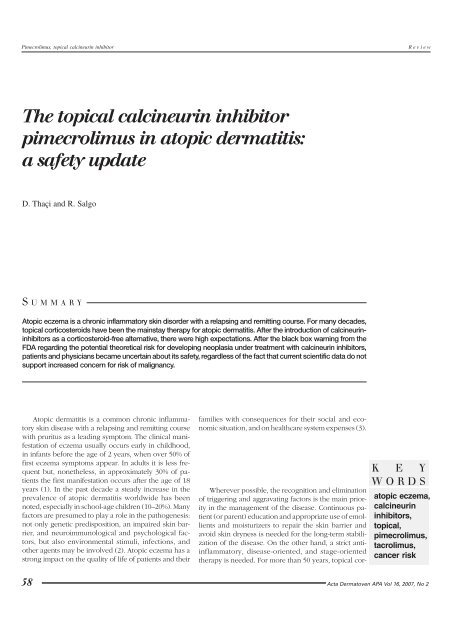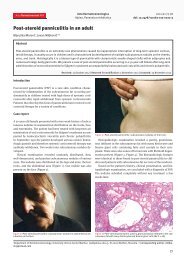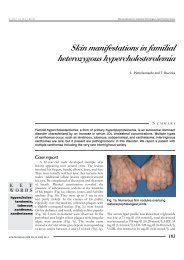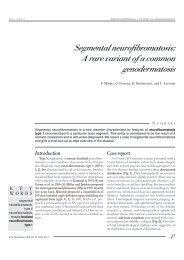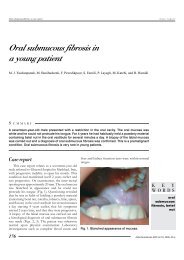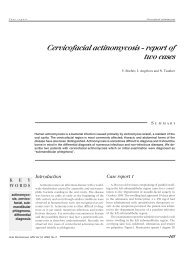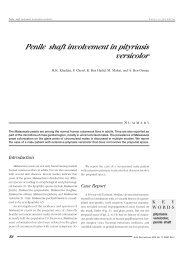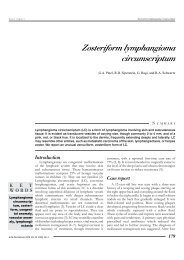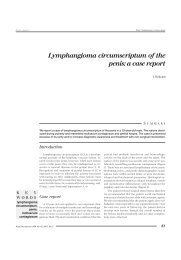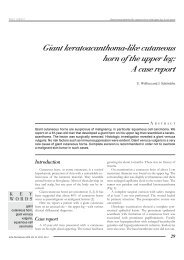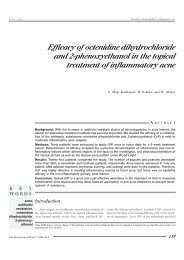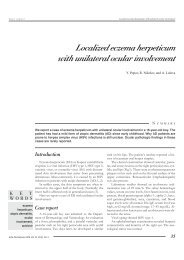The topical calcineurin inhibitor pimecrolimus in atopic dermatitis: a ...
The topical calcineurin inhibitor pimecrolimus in atopic dermatitis: a ...
The topical calcineurin inhibitor pimecrolimus in atopic dermatitis: a ...
Create successful ePaper yourself
Turn your PDF publications into a flip-book with our unique Google optimized e-Paper software.
Pimecrolimus, <strong>topical</strong> <strong>calc<strong>in</strong>eur<strong>in</strong></strong> <strong><strong>in</strong>hibitor</strong><br />
R e v i e w<br />
<strong>The</strong> <strong>topical</strong> <strong>calc<strong>in</strong>eur<strong>in</strong></strong> <strong><strong>in</strong>hibitor</strong><br />
<strong>pimecrolimus</strong> <strong>in</strong> <strong>atopic</strong> <strong>dermatitis</strong>:<br />
a safety update<br />
D. Thaçi and R. Salgo<br />
S U M M A R Y<br />
Atopic eczema is a chronic <strong>in</strong>flammatory sk<strong>in</strong> disorder with a relaps<strong>in</strong>g and remitt<strong>in</strong>g course. For many decades,<br />
<strong>topical</strong> corticosteroids have been the ma<strong>in</strong>stay therapy for <strong>atopic</strong> <strong>dermatitis</strong>. After the <strong>in</strong>troduction of <strong>calc<strong>in</strong>eur<strong>in</strong></strong><strong><strong>in</strong>hibitor</strong>s<br />
as a corticosteroid-free alternative, there were high expectations. After the black box warn<strong>in</strong>g from the<br />
FDA regard<strong>in</strong>g the potential theoretical risk for develop<strong>in</strong>g neoplasia under treatment with <strong>calc<strong>in</strong>eur<strong>in</strong></strong> <strong><strong>in</strong>hibitor</strong>s,<br />
patients and physicians became uncerta<strong>in</strong> about its safety, regardless of the fact that current scientific data do not<br />
support <strong>in</strong>creased concern for risk of malignancy.<br />
Atopic <strong>dermatitis</strong> is a common chronic <strong>in</strong>flammatory<br />
sk<strong>in</strong> disease with a relaps<strong>in</strong>g and remitt<strong>in</strong>g course<br />
with pruritus as a lead<strong>in</strong>g symptom. <strong>The</strong> cl<strong>in</strong>ical manifestation<br />
of eczema usually occurs early <strong>in</strong> childhood,<br />
<strong>in</strong> <strong>in</strong>fants before the age of 2 years, when over 50% of<br />
first eczema symptoms appear. In adults it is less frequent<br />
but, nonetheless, <strong>in</strong> approximately 30% of patients<br />
the first manifestation occurs after the age of 18<br />
years (1). In the past decade a steady <strong>in</strong>crease <strong>in</strong> the<br />
prevalence of <strong>atopic</strong> <strong>dermatitis</strong> worldwide has been<br />
noted, especially <strong>in</strong> school-age children (10–20%). Many<br />
factors are presumed to play a role <strong>in</strong> the pathogenesis:<br />
not only genetic predisposition, an impaired sk<strong>in</strong> barrier,<br />
and neuroimmunological and psychological factors,<br />
but also environmental stimuli, <strong>in</strong>fections, and<br />
other agents may be <strong>in</strong>volved (2). Atopic eczema has a<br />
strong impact on the quality of life of patients and their<br />
families with consequences for their social and economic<br />
situation, and on healthcare system expenses (3).<br />
Wherever possible, the recognition and elim<strong>in</strong>ation<br />
of trigger<strong>in</strong>g and aggravat<strong>in</strong>g factors is the ma<strong>in</strong> priority<br />
<strong>in</strong> the management of the disease. Cont<strong>in</strong>uous patient<br />
(or parent) education and appropriate use of emollients<br />
and moisturizers to repair the sk<strong>in</strong> barrier and<br />
avoid sk<strong>in</strong> dryness is needed for the long-term stabilization<br />
of the disease. On the other hand, a strict anti<strong>in</strong>flammatory,<br />
disease-oriented, and stage-oriented<br />
therapy is needed. For more than 50 years, <strong>topical</strong> cor-<br />
K E Y<br />
WORDS<br />
<strong>atopic</strong> eczema,<br />
<strong>calc<strong>in</strong>eur<strong>in</strong></strong><br />
<strong><strong>in</strong>hibitor</strong>s,<br />
<strong>topical</strong>,<br />
<strong>pimecrolimus</strong>,<br />
tacrolimus,<br />
cancer risk<br />
58 Acta Dermatoven APA Vol 16, 2007, No 2
Pimecrolimus, <strong>topical</strong> <strong>calc<strong>in</strong>eur<strong>in</strong></strong> <strong><strong>in</strong>hibitor</strong><br />
R e v i e w<br />
ticosteroids were the only anti-<strong>in</strong>flammatory treatment<br />
option <strong>in</strong> <strong>atopic</strong> eczema. When used properly and carefully<br />
advised by a physician, they are an excellent tool<br />
and rarely cause adverse events.<br />
Only uncontrolled and long-term application, particularly<br />
<strong>in</strong> sensitive areas like the face or sk<strong>in</strong> folds,<br />
may cause side effects such as sk<strong>in</strong> atrophy, striae, perioral<br />
<strong>dermatitis</strong>, or even systemic effects like adrenocorticoid<br />
suppression (4). Because <strong>atopic</strong> eczema is a<br />
chronic disease that requires long-term treatment, the<br />
<strong>in</strong>troduction of <strong>topical</strong> <strong>calc<strong>in</strong>eur<strong>in</strong></strong> <strong><strong>in</strong>hibitor</strong>s such as<br />
<strong>pimecrolimus</strong> was highly appreciated (5). <strong>The</strong>refore,<br />
expectations were high that the steroid-free anti-<strong>in</strong>flammatory<br />
therapeutic options us<strong>in</strong>g <strong>pimecrolimus</strong> would<br />
be appropriate and safe.<br />
Pimecrolimus: mode of action<br />
Pimecrolimus (Elidel® cream) is a chemical modification<br />
of ascomyc<strong>in</strong> produced by Streptomyces hygroscopicus<br />
var. ascomyceticus and belongs to the immunomodulatory<br />
macrolides <strong>The</strong> mode of action of the <strong>topical</strong><br />
<strong>calc<strong>in</strong>eur<strong>in</strong></strong> <strong><strong>in</strong>hibitor</strong> (CNI) is more cell-selective than that<br />
of corticosteroids. Pimecrolimus blocks the activation of<br />
T-cells <strong>in</strong> affected sk<strong>in</strong> by b<strong>in</strong>d<strong>in</strong>g with cytosolic b<strong>in</strong>d<strong>in</strong>g<br />
prote<strong>in</strong> FKBP-12, a 12 kDa macrophil<strong>in</strong>, and form<strong>in</strong>g a<br />
complex with <strong>calc<strong>in</strong>eur<strong>in</strong></strong>, calmodul<strong>in</strong>, and calcium,<br />
thereby <strong>in</strong>hibit<strong>in</strong>g the phosphatase activity of <strong>calc<strong>in</strong>eur<strong>in</strong></strong>.<br />
<strong>The</strong> dephosphorylization of the nuclear factor of activated<br />
T-cell prote<strong>in</strong> (NF-ATp), a transcription factor necessary<br />
for the expression of pro<strong>in</strong>flammatory cytok<strong>in</strong>es such as<br />
IL-2, TNF-alpha, IL-4, IL-5, is thus <strong>in</strong>hibited. Because there<br />
is no <strong><strong>in</strong>hibitor</strong>y effect on the antigen-present<strong>in</strong>g cells<br />
(APC) (e.g., Langerhans cells) by <strong>pimecrolimus</strong>, the local<br />
immune response is mostly unaffected (6, 7).<br />
Rationale for use<br />
<strong>The</strong> molecular weight of <strong>pimecrolimus</strong>, 810 Da,<br />
enables penetration and permeation <strong>in</strong> and through<br />
<strong>in</strong>tact sk<strong>in</strong>. It is widely accepted that only substances<br />
smaller than 500 Da can penetrate through an <strong>in</strong>tact<br />
sk<strong>in</strong> barrier without restriction. In patients with <strong>atopic</strong><br />
<strong>dermatitis</strong>, the sk<strong>in</strong> barrier is impaired. Due to the larger<br />
size of its molecules, <strong>pimecrolimus</strong> can penetrate<br />
through the stratum corneum and accumulate <strong>in</strong> the<br />
epidermis and dermis, without the tendency to permeate<br />
the blood, so practically no systemic absorption takes<br />
place (8). Pharmacok<strong>in</strong>etic <strong>in</strong>vestigation reveals that<br />
blood serum levels of <strong>pimecrolimus</strong> <strong>in</strong> patients (<strong>in</strong>fants,<br />
children, and adults) undergo<strong>in</strong>g <strong>topical</strong> treatment were<br />
not detectable or extremely low (< 2ng/ml) <strong>in</strong> 99.2% of<br />
cases, and thus any systemic effect was excluded (9,<br />
10). Furthermore, dur<strong>in</strong>g treatment with <strong>pimecrolimus</strong><br />
cream the quality of the sk<strong>in</strong> barrier improves. In addition<br />
to the limited systemic absorption of <strong>pimecrolimus</strong>,<br />
it is also more lipophilic than corticosteroids (molecular<br />
weight mostly under 500 Da), result<strong>in</strong>g <strong>in</strong> a greater<br />
aff<strong>in</strong>ity for the sk<strong>in</strong> compartment and a lower potential<br />
for absorption <strong>in</strong>to systemic circulation (8).<br />
Cl<strong>in</strong>ical efficacy and safety <strong>in</strong> <strong>atopic</strong><br />
<strong>dermatitis</strong><br />
Pimecrolimus 1% cream is approved for: (i) treatment<br />
of mild to moderate <strong>atopic</strong> eczema, (ii) short-term use for<br />
acute signs and symptoms; and (iii) <strong>in</strong>termittent long-term<br />
use to avoid the appearance of acute episodes.<br />
Numerous <strong>in</strong>ternational controlled cl<strong>in</strong>ical studies<br />
prove the efficacy and safety of <strong>pimecrolimus</strong>. Just a few<br />
days (2–4) after <strong>in</strong>itiation of treatment, there is significant<br />
improvement of <strong>atopic</strong> <strong>dermatitis</strong> (11). In patients treated<br />
with <strong>pimecrolimus</strong> cream, the number of flares and the<br />
amount of <strong>topical</strong> steroids used were significantly reduced<br />
(12). An extensive study and cl<strong>in</strong>ical research program<br />
evaluated over 40,000 patients treated with <strong>pimecrolimus</strong><br />
<strong>in</strong> various age groups, also compris<strong>in</strong>g <strong>in</strong>fants under the<br />
age of 2 (13). An extremely large number of patients used<br />
it dur<strong>in</strong>g the postmarket<strong>in</strong>g phase (14).<br />
FDA warn<strong>in</strong>g<br />
On February 2005 the pediatric advisory committee<br />
of US Food and Drug Adm<strong>in</strong>istration (FDA) recommended<br />
a black box warn<strong>in</strong>g for the <strong>pimecrolimus</strong><br />
cream (Elidel®) and the tacrolimus o<strong>in</strong>tment<br />
(Protopic®), justify<strong>in</strong>g their concerns regard<strong>in</strong>g potential<br />
safety risks (15). <strong>The</strong>se were ma<strong>in</strong>ly directed aga<strong>in</strong>st<br />
extensive off-label use, especially <strong>in</strong> <strong>in</strong>fants under the<br />
age of 2, and uncontrolled cont<strong>in</strong>uous long-term application,<br />
and were not primarily focused on the few reports<br />
of lymphoma. <strong>The</strong> warn<strong>in</strong>g regard<strong>in</strong>g the potential<br />
risk of cancer was based on 20 case reports of lymphoma<br />
and 10 cases of sk<strong>in</strong> neoplasm worldwide <strong>in</strong><br />
patients treated with tacrolimus and/or <strong>pimecrolimus</strong><br />
(16). Like all such reports, the majority of these were<br />
s<strong>in</strong>gle cases reported spontaneously without an exact<br />
verification of the causal relation between CNI and carc<strong>in</strong>omas,<br />
and none of them resulted from any systematic<br />
scientific analysis prov<strong>in</strong>g an <strong>in</strong>creased cancer risk<br />
(16, 17).<br />
Despite the absence of a verified causal relationship<br />
for an <strong>in</strong>creased risk of neoplasms, the FDA issued<br />
a warn<strong>in</strong>g on the potential risk of neoplasms follow<strong>in</strong>g<br />
the <strong>topical</strong> application of CNIs. Op<strong>in</strong>ion leaders and<br />
experts worldwide disagreed with and even strongly<br />
criticized the FDA decision, demand<strong>in</strong>g withdrawal of<br />
the warn<strong>in</strong>g (18–20). However, the FDA did not decide<br />
to modify essentially its orig<strong>in</strong>al decision on<br />
<strong>pimecrolimus</strong> (15).<br />
60 Acta Dermatoven APA Vol 16, 2007, No 2
R e v i e w<br />
Pimecrolimus, <strong>topical</strong> <strong>calc<strong>in</strong>eur<strong>in</strong></strong> <strong><strong>in</strong>hibitor</strong><br />
Increased cancer risk: scientific<br />
background or mis<strong>in</strong>terpretation?<br />
Modern drugs such as <strong>pimecrolimus</strong> must undergo<br />
<strong>in</strong>tensive precl<strong>in</strong>ical research to exclude any potential<br />
risk before they are approved for use <strong>in</strong> humans. Animal<br />
models are valuable tools to evaluate the safety<br />
concerns. <strong>The</strong> importance of f<strong>in</strong>d<strong>in</strong>gs <strong>in</strong> animal models<br />
and <strong>in</strong> vitro studies should not be overestimated;<br />
they have limits <strong>in</strong> <strong>in</strong>terpretation and are not objective<br />
without tak<strong>in</strong>g <strong>in</strong>to consideration the specific application<br />
<strong>in</strong> humans. <strong>The</strong> first step to show any systemic effect<br />
should be to prove that a <strong>topical</strong>ly applied<br />
<strong>calc<strong>in</strong>eur<strong>in</strong></strong> <strong><strong>in</strong>hibitor</strong> permeates and enters the blood<br />
circulation (21, 22). In an animal experiment, <strong>in</strong>creased<br />
blood levels of <strong>pimecrolimus</strong> were measured after <strong>topical</strong><br />
application of an alcoholic solution of <strong>pimecrolimus</strong>.<br />
In this model there was an <strong>in</strong>creased risk for develop<strong>in</strong>g<br />
tumors (23). Consider<strong>in</strong>g the fact that the drug levels<br />
measured <strong>in</strong> this experiments were 60-fold higher<br />
than the highest dosage ever measured after <strong>topical</strong><br />
application <strong>in</strong> humans, this suggests that any risk exists<br />
almost exclusively only <strong>in</strong> theory (13, 16, 17, 21). Furthermore,<br />
<strong>in</strong> 99.2% of samples taken from patients <strong>topical</strong>ly<br />
treated with 1% <strong>pimecrolimus</strong> the serum levels<br />
were below the limit of detection or < 2ng/ml (9, 10).<br />
Upon analyz<strong>in</strong>g the details of the reported lymphomas,<br />
it is noteworthy that they differ cl<strong>in</strong>ically and histologically<br />
from commonly observed cases. Thus, there<br />
is reason to suspect that these patients may never have<br />
had <strong>atopic</strong> <strong>dermatitis</strong>, but were treated for a pre-exist<strong>in</strong>g<br />
condition mimick<strong>in</strong>g eczema (19).<br />
Another argument for mis<strong>in</strong>terpret<strong>in</strong>g the risk is that<br />
the reported cancer rate <strong>in</strong> patients under treatment with<br />
<strong>topical</strong> <strong>pimecrolimus</strong> is much lower than the expected<br />
<strong>in</strong>cidence of cancer <strong>in</strong> the normal population: <strong>The</strong> lymphoma<br />
ratio is 22:100,000, the ratio of non-melanoma sk<strong>in</strong><br />
neoplasm is 533:100,000, and the malignant melanoma<br />
ratio is 14:100,000 (15). Consider<strong>in</strong>g these data, there is<br />
no evidence that the <strong>in</strong>cidence is <strong>in</strong>creased <strong>in</strong> the population<br />
treated with <strong>topical</strong> <strong>calc<strong>in</strong>eur<strong>in</strong></strong> <strong><strong>in</strong>hibitor</strong>s; <strong>in</strong> fact,<br />
the rate is lower than expected. This is a very <strong>in</strong>terest<strong>in</strong>g<br />
R E F E R E N C E S<br />
f<strong>in</strong>d<strong>in</strong>g <strong>in</strong> view of the per se <strong>in</strong>creased rate of neoplasm<br />
<strong>in</strong> patients with <strong>atopic</strong> <strong>dermatitis</strong> (lymphoma 2 times<br />
higher and non-melanotic sk<strong>in</strong> cancer 1.5 times higher<br />
compared to the normal population) (24, 25).<br />
<strong>The</strong>re is no doubt that <strong>in</strong>itial enthusiasm <strong>in</strong> us<strong>in</strong>g <strong>topical</strong><br />
<strong>calc<strong>in</strong>eur<strong>in</strong></strong> <strong><strong>in</strong>hibitor</strong>s is partially replaced by more<br />
cautious guidel<strong>in</strong>es <strong>in</strong> <strong>atopic</strong> <strong>dermatitis</strong> patients with a<br />
need for anti-<strong>in</strong>flammatory therapy. <strong>The</strong> contentious<br />
po<strong>in</strong>ts made by the FDA cannot be solved by discussions<br />
and statements. Long-term observational safety studies<br />
are underway to evaluate the risk for cancer. <strong>The</strong>y should<br />
prove and critically evaluate the efficacy and safety (14).<br />
<strong>The</strong> current data do not support <strong>in</strong>creased concern for<br />
development of malignancies. <strong>The</strong>re is no doubt that <strong>topical</strong><br />
<strong>calc<strong>in</strong>eur<strong>in</strong></strong> <strong><strong>in</strong>hibitor</strong>s such as <strong>pimecrolimus</strong> should<br />
be prescribed by physicians experienced <strong>in</strong> treat<strong>in</strong>g <strong>atopic</strong><br />
<strong>dermatitis</strong>. Physicians and patients (and parents of underage<br />
patients) must be educated about the correct use<br />
of the medication <strong>in</strong> order to avoid drug side effects. Patients<br />
should be advised to use a conventional sun protection<br />
product while be<strong>in</strong>g treated with <strong>topical</strong> CNIs.<br />
Both <strong>topical</strong> CNIs as well as <strong>topical</strong> corticosteroids<br />
are essential tools for the treatment of <strong>atopic</strong> eczema.<br />
Particularly for the treatment of sensitive sk<strong>in</strong> areas such<br />
as the face and the <strong>in</strong>tertrig<strong>in</strong>ous areas, <strong>pimecrolimus</strong><br />
should be considered the treatment of choice. Effective<br />
treatment of <strong>atopic</strong> eczema requires multimodal<br />
therapeutic concepts with respect to the different stages<br />
of the disease: moisturiz<strong>in</strong>g emollients, strategies to<br />
avoid the itch-scratch cycle, and symptomatic anti-<strong>in</strong>flammatory<br />
treatment accompanied by efforts to elim<strong>in</strong>ate<br />
or avoid any possible trigger factors.<br />
Treat<strong>in</strong>g <strong>atopic</strong> <strong>dermatitis</strong> with new <strong>topical</strong> CNIs<br />
such as <strong>pimecrolimus</strong> reduces the amount of <strong>topical</strong><br />
steroids needed and reduces the number of flare-ups.<br />
However, there should be no tendency to replace <strong>topical</strong><br />
corticosteroids because the two treatments complement<br />
one another.<br />
1. Charman C, Williams HC. Epidemiology. In: Bieber T, Leung DYM, editors. Atopic <strong>dermatitis</strong>. 1st ed.<br />
New York: Marcel Dekker Inc.; 2002. p. 21–42.<br />
2. H<strong>in</strong>z T, Staudacher A, Bieber T. Neues <strong>in</strong> der Pathophysiologie der atopischen Dermatitis. Hautarzt.<br />
2006;7:567–75.<br />
3. Fivenson D, Goldberg-Arnold RJ, Kaniecki DJ, Cohen JL, Frech F, F<strong>in</strong>lay AY. <strong>The</strong> effect of <strong>atopic</strong> <strong>dermatitis</strong><br />
on total burden of illness and quality of life on adults and children <strong>in</strong> a large managed care organization.<br />
J Manag Care Pharm. 2002;8(5):333–42.<br />
4. Thaçi D. Long term management of childhood <strong>atopic</strong> <strong>dermatitis</strong> with <strong>calc<strong>in</strong>eur<strong>in</strong></strong> <strong><strong>in</strong>hibitor</strong>s. Hautarzt.<br />
2003;54(5):418–23.<br />
5. Hengge UR, Ruzicka T, Schwartz RA, Cork MJ. Adverse effects of <strong>topical</strong> glucocorticosteroids. J Am<br />
Acad Dermatol. 2006;54(1):1–15.<br />
6. Alomar A, Berth-Jones J, Bos JD, Giannetti A, Reitamo S, Ruzicka T, et al. <strong>The</strong> role of <strong>topical</strong> <strong>calc<strong>in</strong>eur<strong>in</strong></strong><br />
<strong><strong>in</strong>hibitor</strong>s <strong>in</strong> <strong>atopic</strong> <strong>dermatitis</strong>. Br J Dermatol. 2004;151(70):3–27.<br />
Acta Dermatoven APA Vol 16, 2007, No 2 61
Pimecrolimus, <strong>topical</strong> <strong>calc<strong>in</strong>eur<strong>in</strong></strong> <strong><strong>in</strong>hibitor</strong><br />
R e v i e w<br />
7. Stuetz A, Baumann K, Grassberger M, Wolff K, Me<strong>in</strong>gassner JG. Discovery of <strong>topical</strong> <strong>calc<strong>in</strong>eur<strong>in</strong></strong> <strong><strong>in</strong>hibitor</strong>s<br />
and pharmacological profile of <strong>pimecrolimus</strong>. Int Arch Allergy Immunol. 2006;141(3):199–212.<br />
8. Bos JD. Non-steroidal <strong>topical</strong> immunomodulators provide sk<strong>in</strong>-selective, self-limit<strong>in</strong>g treatment <strong>in</strong><br />
<strong>atopic</strong> <strong>dermatitis</strong>. Eur J Dermatol. 2003;13(5):455–61.<br />
9. Van Leent EJ, Ebel<strong>in</strong> ME, Burt<strong>in</strong> P, Dorobek B, Spuls PI, Bos JD. Low systemic exposure after repeated<br />
<strong>topical</strong> application of <strong>pimecrolimus</strong> (Elidel, SD Z ASM 981) <strong>in</strong> patients with <strong>atopic</strong> <strong>dermatitis</strong>. Dermatology.<br />
2002;204(1):63–8.<br />
10. Paul C, Cork M, Rossi AB, Papp KA, Barbier N, de Prost Y. Safety and tolerability of 1% <strong>pimecrolimus</strong><br />
cream among <strong>in</strong>fants: experience with 1133 patients treated for up to 2 years. Pediatrics. 2006;<br />
117(1):e118–28.<br />
11. Kaufmann R, Folster-Holst R, Hoger P, Thaçi D, Loffler H, Staab D, et al. Onset of action of <strong>pimecrolimus</strong><br />
cream 1% <strong>in</strong> the treatment of <strong>atopic</strong> eczema <strong>in</strong> <strong>in</strong>fants. J Allergy Cl<strong>in</strong> Immunol. 2004;114(5):1183–8.<br />
12. Wahn U, Bos JD, Goodfield M, Baputo R, Papp K, Manjra A, et al. Efficacy and safety of <strong>pimecrolimus</strong><br />
cream <strong>in</strong> the long-term management of <strong>atopic</strong> <strong>dermatitis</strong> <strong>in</strong> children. Pediatrics. 2002;110(e2):1–8.<br />
13. Hultsch T, Kapp A, Spergel J. Immunomodulation and safety of <strong>topical</strong> <strong>calc<strong>in</strong>eur<strong>in</strong></strong> <strong><strong>in</strong>hibitor</strong>s for the<br />
treatment of <strong>atopic</strong> <strong>dermatitis</strong>. Dermatology. 2005;211(2):174–87.<br />
14. Sunderkötter, C, Weiss JM, Bextermöller R, Löffler H, Schneider D. Post-market<strong>in</strong>g surveillance on treatment<br />
of 5,665 patients with <strong>atopic</strong> <strong>dermatitis</strong> us<strong>in</strong>g the <strong>calc<strong>in</strong>eur<strong>in</strong></strong> <strong><strong>in</strong>hibitor</strong> <strong>pimecrolimus</strong>: positive effects<br />
on major symptoms of <strong>atopic</strong> <strong>dermatitis</strong> and on quality of life. J Dtsch Dermatol Ges. 2006;4:301–7.<br />
15. Fonacier L, Charlesworth EN, Spergel JM, Leung DY. <strong>The</strong> black box warn<strong>in</strong>g for <strong>topical</strong> <strong>calc<strong>in</strong>eur<strong>in</strong></strong><br />
<strong><strong>in</strong>hibitor</strong>s: look<strong>in</strong>g outside the box. Ann Allergy Asthma Immunol. 2006;97(1):117–20.<br />
16. Ormerod AD. Topical tacrolimus and <strong>pimecrolimus</strong> and the risk of cancer: how much cause for<br />
concern? Br J Dermatol. 2005;153(4):701–5.<br />
17. Arellano FM, Wentworth CE, Arana A, Fernandez C, Paul CF. Risk of lymphoma follow<strong>in</strong>g exposure to<br />
<strong>calc<strong>in</strong>eur<strong>in</strong></strong> <strong><strong>in</strong>hibitor</strong>s and <strong>topical</strong> steroids <strong>in</strong> patients with <strong>atopic</strong> <strong>dermatitis</strong>. J Invest Dermatol.<br />
2007;127(4):808–16.<br />
18. Bieber T, Cork M, Ellis C, Girolomoni G, Groves R, Langley R, et al. Consensus statement on the safety<br />
profile of <strong>topical</strong> <strong>calc<strong>in</strong>eur<strong>in</strong></strong> <strong><strong>in</strong>hibitor</strong>s. Dermatology. 2005;211:77–8.<br />
19. Berger TG, Duvic M, Van Voorhees AS, VanBeek MJ, Frieden IJ. <strong>The</strong> use of <strong>topical</strong> <strong>calc<strong>in</strong>eur<strong>in</strong></strong> <strong><strong>in</strong>hibitor</strong>s<br />
<strong>in</strong> dermatology: safety concerns. Report of the American Academy of Dermatology Association Task<br />
Force. J Am Acad Dermatol. 2006;54(5):818–23.<br />
20. Bigby M. Tacrolimus and <strong>pimecrolimus</strong> for <strong>atopic</strong> <strong>dermatitis</strong>: Where do they fit <strong>in</strong>? Arch Dermatol.<br />
2006;142(9):1203–5.<br />
21. R<strong>in</strong>g J, et al. Review of the potential photo-cocarc<strong>in</strong>ogenicity of <strong>topical</strong> <strong>calc<strong>in</strong>eur<strong>in</strong></strong> <strong><strong>in</strong>hibitor</strong>s. Position<br />
statement of the European Dermatology Forum. J Eur Acad Dermatol Venereol. 2005;19:663–71.<br />
22. Stuetz A, Baumann K, Grassberger M, Wolff K, Me<strong>in</strong>gassner JG. Discovery of <strong>topical</strong> <strong>calc<strong>in</strong>eur<strong>in</strong></strong> <strong><strong>in</strong>hibitor</strong>s<br />
and pharmacological profile of Pimecrolimus. Int Arch Allergy Immunol. 2006;141(3):199–212.<br />
23. Niwa Y, Nasr I. Are we start<strong>in</strong>g to <strong>in</strong>duce sk<strong>in</strong> cancer <strong>in</strong> order to avoid <strong>topical</strong> steroids? J Eur Acad<br />
Dermatol Venereol. 2005;19(3):380–99.<br />
24. Wang H, Diepgen TL. Atopic <strong>dermatitis</strong> and cancer risk. Br J Dermatol. 2006;154(2):205–10.<br />
25. Hagstroemer L, Ye W, Nyren O, Emtestam L. Incidence of cancer among patients with <strong>atopic</strong> <strong>dermatitis</strong>.<br />
Arch Dermatol. 2005;141(9):1123–7.<br />
A U T H O R S '<br />
ADDRESSES<br />
Diamant Thaçi, MD, Zentrum der Dermatologie und Venerologie,<br />
Johann Wolfgang Goethe-Universität, <strong>The</strong>odor-Stern-Kai 7, D–60590<br />
Frankfurt /Ma<strong>in</strong>, Germany, E-mail: thaci@em.uni-frankfurt.de<br />
Rebekka Salgo MD, same address<br />
62 Acta Dermatoven APA Vol 16, 2007, No 2


